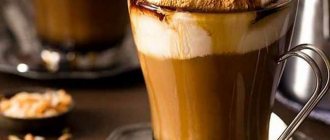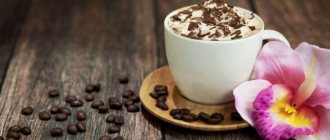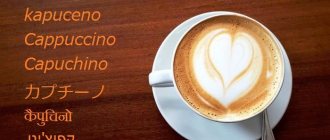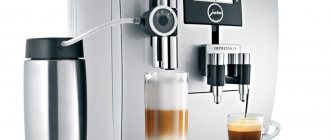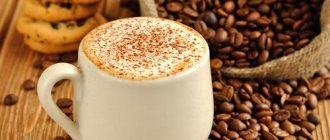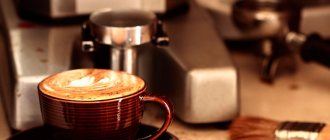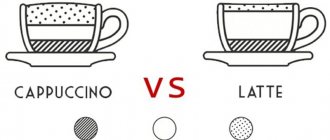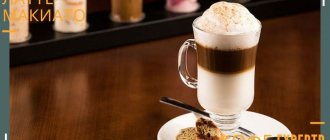What is the difference between a latte and a cappuccino.
Modern coffee shops offer a wide variety of drinks. Choosing something from the assortment can be problematic, especially when the cocktails do not differ in composition. First, this applies to lattes and cappuccinos, they both contain coffee and milk. In general, this is where their similarities end. What is the difference between these types of coffee that are similar at first glance?
Ingredient proportions
This is the first difference between latte and cappuccino. Despite the fact that both contain milk, coffee and foam, the proportions of the components are different.
- Latte. It contains twice as much milk as coffee or milk foam and is therefore considered an espresso-based cocktail. Half of the composition is heated milk, and the other half is other ingredients.
- Cappuccino. It contains all three components in equal proportions, which is why it is considered a type of coffee.
In other words, their main difference is the concentration of milk, which is lower in the second drink.
Milk foam
Their foam also differs in structure, density and appearance.
- Latte. This is a very gentle and soft drink, and its foam is light and airy. In most cases, its shape resembles a lush dome, which simply allows sugar to pass through itself and is suitable for drawing ornaments. The decoration technique is called latte art. A correctly executed pattern should remain on the surface for 12 minutes, even if everything has already been drunk. The foam with decoration simply settles to the bottom of the glass.
- Cappuccino. The foam is languid and thick, darker in color than a cocktail. If properly whipped, it will even withstand the weight of certain objects. This is easy to check in practice: the foam will not sag under the weight of a spoon or sugar poured onto it, which cannot be said about cocktail foam.
But for both latte and cappuccino, the foam should be completely homogeneous and free of bubbles.
Serving method
Traditionally, lattes and cappuccinos are served using different methods. Knowing what glasses they are poured into and in what volumes they are usually served, it is difficult to make a mistake in your choice.
- Latte. Virtually all coffee cocktails are served in glass glasses and this cocktail is no exception. It is prepared in an Irish glass, which should normally be made of heat-resistant glass. The glass retains its temperature for a long time and it must have a handle. The usual serving is 240-360 ml. Usually served at a temperature of about 70 degrees. In Italy it was drunk during the day, but at the moment there are no time restrictions.
- Cappuccino. This coffee drink is consumed from porcelain cups with a capacity of 180 ml. The walls of the cup are made of thick-walled porcelain, and the inside of the vessel is covered with durable enamel. The cup should be cone-shaped, tapering towards the top. Only in this case, the dense foam covering the drink will be enough for the entire volume of coffee.
Strength and smell
The key difference between these drinks is their taste and smell.
- Latte. The coffee taste is smoothed out by milk. The astringency is virtually not felt, and if sugar is added, it is completely lost. That’s why the taste of this cocktail is considered mild. The smell is very subtle and you can't actually smell the coffee.
- Cappuccino. Thanks to the composition, the strength and smell of coffee is better felt in it. The taste is coffee and more intense with minor milky notes.
Espresso
The classic espresso cup is called a demitasse (from the French demi-tasse, “half cup”). It has a small volume, only 60-90 ml, and is most often made of porcelain. Demitass serves ristretto, espresso, macchiato - small coffee with a drop of milk foam.
A special feature of demitasses suitable for espresso is their thick walls. Thanks to them, you will have time to enjoy your drink before it starts to cool down. By the way, the cup must be warmed up before preparing espresso - espresso is prepared directly into the cup, and if it is cold, the drink will have time to cool down during preparation, which will significantly worsen its taste. If your coffee machine does not have a function for heating dishes, you can simply hold hot water in the cup for a while, and only then prepare espresso in it.
In terms of volume, demitasse is also suitable for double espresso, but this drink is often served in a larger cup, about 150 ml. Firstly, in this case the aroma is revealed more clearly - this is especially noticeable if you rotate the cup a little before the first sip so that the cream starts to move. Secondly, in a large cup it is more convenient to mix the cream and make the drink more homogeneous and balanced in taste. And thirdly, double espresso is not a drink that must be drunk before it cools down: its taste will develop differently at different temperatures, so you can take your time and savor every sip. However, thick walls are also desirable for such a cup, for the same reason: so that the drink does not cool down too quickly.
The shape of an espresso cup also matters: most often, its inner surface will be rounded and tapered downwards, ovoid - this way the drink will be better distributed in the cup. In addition, Brazilian multisensory perception researcher Fabiana Carvalho has shown that round shapes are associated with sweetness, and in a rounded cup the taste of espresso is perceived as sweeter. The edge of the espresso cup is also rounded, which enhances this effect and allows you to feel the body of the drink as creamier.
Fabiana Carvalho's project The Coffee Sensorium is dedicated to the study of specialty coffee in the context of multisensory perception of taste. Photo by sprudge.com.
The founder of the Parisian roasting company L'Arbre de Cafe, Hippolyte Courti, tested more than 400 coffee cups and created his own - a perfectly spherical shape. This cup is made of sandstone and has a rough, “granular” surface that feels reminiscent of ground coffee. Another detail that Kurti paid attention to was the thin edge of the cup. In his opinion, thick edges make our brain perceive espresso as something “heavy” - heavy, dense, viscous. When there is no barrier between our lips and the drink, we don’t load our brains with expectations and try coffee as if “from scratch.” Kurti uses these cups in his own coffee shop, and they can also be found in some restaurants in Paris.
And a little about color: according to my observations, the brightest taste of espresso is felt in a cup that is white on the inside - perhaps because this creates the maximum contrast between the coffee and the dishes. On a bright or black background, the taste is somewhat “lost.” Manufacturers of coffee cups most often make the cups white on the inside, but the outside of the cup can be any color - it’s a matter of taste and mood.
Double espresso in a Redneck Ware 80 ml ceramic cup.
Manufacturing methods
The usual production design, both latte and cappuccino, is completely monotonous. But at the moment there are various cooking recipes.
- Latte. From time to time this cocktail is prepared like this. First, whipped milk, heated to 70 degrees, is poured, and then espresso is carefully added to it. This helps achieve a layered effect.
- Cappuccino. It is always prepared using the usual method. Milk is added to the roast espresso and then stirred until smooth.
Conclusions So, you can simply find out what the differences are between these two coffee drinks.
Latte: This is an espresso-based cocktail, half of which is milk. Its foam is light and resembles a dome and can be used for drawing various ornaments on it. Served in Irish glasses. It has a mild taste, smoothed by milk, and a faintly tangible odor.
Cappuccino: This is a coffee option that has a thick, dense foam that can withstand the weight of a spoon or sugar. Served in cups with a wide top. It has a strong taste with notes of milk and a distinctive aroma.
We also recommend reading about the differences between Americano and espresso.
Cappuccino and latte: differences in the manufacturing process and recipes.
Any of us can fully enjoy the fragrant strength of cappuccino and the unique taste of latte. But not everyone thinks that these two drinks are different from each other. If you are not an experienced and specific coffee lover, then it may seem that they are very similar, because in both cases milk and coffee are mixed together. In reality, there are certain subtleties that allow you to create a unique taste for latte and cappuccino coffee.
Cup
Coffee brewed in pour over is served in small wide cups or smooth glasses. Usually you don’t pour the whole drink into a cup, but add small portions from the decanter. This is done in order to try coffee at different temperatures: as it cools, the coffee changes, revealing its acidity and sweetness, and the nuances of taste are better felt in a warm drink than in a hot one. Properly brewed coffee will be tasty even when it has completely cooled down.
It is worth mentioning separately about the shapes of cups for black coffee, since the difference in shape allows you to experience dramatic changes in taste. One of the most vivid taste experiences for me was getting acquainted with KRUVE glasses, the creation of which took into account many scientifically proven factors that influence taste. They are made of borosilicate glass and have different shapes: the first glass is narrow and long, the second is onion-shaped, more open and with a wider surface area. As a result, the same coffee in the first glass is perceived as sweeter and denser, and in the second - as light and bright.
Here are Figgjo Oslo cups from Tim Wendelboe. Tulip, with a wide base and tapered top, is designed for low acidity coffees and helps bring out the sweetness. Split, in which both the base and top are expanded, is intended for acidic coffee - both aroma and acidity are revealed brighter in this form. Open is a U-shaped cup for a balanced, fruity coffee. The fun thing, Tim says, is playing with different shapes and different coffees, changing the perception of the taste.
Photo andershusa.com.
Differences in manufacturing recipes
The difference between a latte and a cappuccino may seem insignificant, since the ingredients for making it are similar. You need coffee and sugar, milk and toppings, which are added to taste and optional. It should be noted that the development of the production of drinks is different from each other; they have completely different taste, presentation and serving.
The main difference between a latte and a cappuccino is the ratio of coffee, milk and milk foam used to make the tasty drink.
Traditional latte recipe
Please note that latte belongs to the group of milk-based cocktails. The concentration of espresso in the drink is low:
- ? part of the coffee.
- If cream is used to make a drink, then take half the cream and half the milk; otherwise, use 3/5 of the milk.
- 1/5 part milk foam.
Technological map of cappuccino
The concentration of espresso in this drink is significantly higher, which is why it is classified as coffee and not coffee-based cocktails. Includes:
- 1/3 part espresso;
- 1/3 part milk;
- 1/3 part milk foam;
- topping and sugar as desired.
Characteristics of cappuccino
As for the preparation of masterpieces, cappuccino coffee requires certain conditions and characteristics that must be adhered to in order to obtain the desired result.
- Quality coffee is essential. It can be a blend of Arabica and Robusta or pure Arabica medium roast.
- For 50-100 ml of water you need about 15 g of ground coffee and 60-90 ml of milk.
- The pressure in the coffee machine is about 8-10 bar.
- The water temperature for espresso is 85-90 degrees, and the milk temperature is 60-70 degrees.
- Cooking time averages 1-2 minutes.
- The cappuccino volume should be 150-180 ml, 360 l for a double portion.
- Caffeine content: 50-75 mg per standard serving.
- When serving, the temperature of the drink should be 60-63 degrees.
- The calorie content of one serving without sugar is about 36-56 calories, depending on the fat content of the milk.
- The norm for consumption per day is 3-4 servings of 180 ml.
Difference in cooking process
Despite the similar composition, the development of the production of drinks is very different.
There are several methods you can use to make a latte: latte macchiato and traditional latte. To make the first one, it is recommended to pour previously heated milk or its mixture with cream into a glass, and then add coffee. As for the traditional version, it is prepared like cappuccino, only the proportions are different. Foam can be added before pouring in the espresso or added at the very end. Before this, lattes were not stirred, but sought to achieve a layered structure; now the trend is for a homogeneous drink, so mixing is allowed.- To make cappuccino, pour a portion of coffee into a container, then add milk that has previously undergone the frothing process, and spread the resulting foam on top. It is not customary to stir the drink.
Coffee classics
Oriental coffee is one of the very first ways of making coffee. This method of preparation does not involve a coffee machine; coffee is prepared here in a special container - a copper Turk on a hot surface - for example, hot sand. At home, you can use salt instead of sand. It is very important that the coffee is freshly ground, and the degree of grinding should be high - otherwise the coffee grounds will be felt in the mouth, which should not be the case.
Important! If the drink is prepared over a fire, do not allow it to boil.
Oriental coffee is served in small coffee cups with a glass of chilled water.
Oriental coffee served with a glass of cold water
Milk foam structure
Latte foam is characterized by looseness; it is not able to hold even the lightest elements created for decoration on its surface. In a latte, its layer is not very high; it is only a decoration for the coffee cocktail, and not its full-fledged flavor component.
As for cappuccino, the foam in it is more dense, despite the saturation with air. Cocoa or cinnamon powder sprinkled on top, sugar stays on the surface of the film for a long time without settling down. The foam layer should always be the highest.
The foam for making latte is whipped a little less than for cappuccino. To achieve the best results for cappuccino, use milk with a high percentage of fat content.
Classic cappuccino recipe
No matter how tempting and tasty the cappuccino variations may be, the classic recipe deserves special attention for its uniqueness and exquisite taste.
As mentioned earlier, to prepare a classic drink, one of the key roles is played by the composition of cappuccino: maintaining the proportions of milk, coffee and foam, which should be 1:1:1. Nowadays, baristas prepare cappuccino using a coffee machine, which makes the task easier.
First, a double portion of espresso is poured into the cup, then the same amount of milk and the top is decorated with a lush cap of milk foam. Also, there is an option when milk is not poured into coffee, but simply whipped up more foam using a cappuccino machine, so that it not only settles on top of the coffee, but also dissolves a little in it.
Ingredients:
- Espresso coffee – 60 ml;
- Milk or cream – 60 l;
- Sugar and additives - to taste.
Differences in the tastes of drinks
Does the development of how drinks are made affect their taste?
Latte has a gentle and creamy milky taste, since it is not as strong as cappuccino. If you don't add sugar to it, it tastes like regular milk. The quality of coffee in this case does not play a very significant role, since its concentration in the drink is low. The foam of the drink is saturated with oxygen, which is why it is loose, light, with a gentle milky taste.
Cappuccino has a distinct coffee taste. Using milk only manages to highlight the aroma of espresso. If you drink it without sugar, you can feel the nutty notes that complement the strong coffee.
The foam is compacted, which has a pronounced milky taste; it can be supplemented with cocoa, cinnamon or chocolate.
Espresso as the basis
The common denominator of all three drinks - Americano, cappuccino, latte - is the presence of espresso in their composition.
It is prepared using a coffee machine as follows: hot water (90–95 °C) passes through a filter with ground coffee under extremely high pressure (9–11 bar), resulting in the most concentrated coffee drink in the cup. One serving of classic espresso requires 25–35 ml of water and 7–10 g of ground coffee. There are other options: lungo - with less coffee for the same volume of water and doppio - with more.
The nuances of coffee consumption
The usual approach calls for drinking before noon. Italians are convinced that these are morning drinks because they contain milk. If you familiarize yourself with Russian information channels, there are no strict restrictions, there are only tips.
How to drink a latte:
- Suitable for consumption between meals, as it can be worn out in huge volumes.
- There is not enough caffeine in its composition, so you can drink it even in the evening.
- Usually, a napkin, spoon and straw are served with the glass. We hold the glass with a napkin so as not to burn ourselves, stir the drink with a spoon, and drink with a straw.
- Fruit and curd flavors are in amazing harmony with the taste of latte. Cheesecakes, soufflés and mousses are the perfect addition to the drink.
- The delicate palette of the drink is stunningly complemented by nut-flavored sweets or chocolate ice cream.
- If you prefer low-calorie desserts, it is recommended to pay attention to raspberry sorbet, strawberry pudding or fruit marshmallow.
For cappuccino lovers:
- The composition contains a high concentration of caffeine, so they should complete a light lunch or snack.
- They drink it through foam. The delicate milky flavor helps bring out the unique bitter taste of espresso.
- It is not customary to stir cappuccino; it is a sign of bad taste.
- In order to more fully experience the versatility of the taste, adding sugar to the drink is contraindicated.
- Creamy and chocolate flavors blend amazingly with cappuccino. Buttercream, panna cotta and brownies are perfect.
- If you like to treat yourself to unusual desserts, we recommend that you pay attention to peach mousse or coconut cookies.
- If you have to count calories, then choose meringue or strawberry jelly - desserts that are virtually fat-free.
The history of coffee is very rich. Now this is a trend, as it was many years ago, because every connoisseur is offered a huge number of types of coffee: Americano, mochaccino, glasse, raf and simple instant drinks, for example, coffee white. They are made using different methods, so try and choose.
Making cappuccino in a coffee machine is a new life for your coffee lover.
How to choose a cappuccino cup?
In order to get the best representative, it is enough that the selected cup meets some basic parameters.
Volume
You can follow the path of our restaurateurs and buy dishes of universal volume, for example, 200 ml. The latest collections of some manufacturers include cappuccino cups and larger sizes, up to 275 ml. The best container for preparing this type of coffee is 170-180 ml. It holds a moderate portion of a strong drink and a tall head of foam.
Connoisseurs of traditions and rituals can opt for a 120 ml cup. This is the classic cappuccino size.
Material
The thicker the walls of such a cup, the better they will retain heat, and the foam will remain strong and high for a long time. Therefore, the ideal choice of material for cappuccino cups would be:
- Ceramics
- Clay
- Thick-walled porcelain
Ceramic and clay cups must be coated with good enamel that will not crack from frequent contact with hot water.
Signs of a high-quality inner cup coating:
- Uniform surface, no depressions
- Glossy shine
- Uniform color
- No chips or unevenness
- Smooth edges
- Smooth structure
Color
The classic shade for a cup is white. It has a number of advantages.
- Emphasizes the rich and soft shade of cappuccino.
- Suitable for any table setting
- Versatile for any occasion - a gala dinner or a party with friends.
Even white color can be varied, which is what modern manufacturers do. Cappuccino cups in classic collections are available in milky or vanilla tones, as well as a popular shade called “champagne splash.”
A novelty in the Art Nouveau style can be called cappuccino cups without handles, but with rubber inserts. Such areas do not heat up and the dishes can be held with all your fingers wrapped around them.
Some classic lovers prefer coffee cups with ornaments; special collections with gilding, elegant patterns or floral motifs in English and French styles have been released for them.
Form
A good cappuccino cup tapers towards the base, and the walls are quite high, from 5 cm. It can expand towards the edges, resembling a bowl or look like a glass.
Manufacturer
The abundance of coffee utensils on store shelves is amazing, as is the variety of manufacturers. Those who carefully monitor the quality of things can be advised to take a closer look at several brands with a good reputation.
- Bernadotte . A Czech brand that produces porcelain tableware, including classic cappuccino cups with a volume of 120 ml. White color, golden rim - the traditional appearance of the dishes will delight connoisseurs of elegance. The price for a coffee pair is about 500 rubles. Individual cups are quite difficult to find; more often the dishes are sold in sets for 6 people.
- Weimar . The German brand is known for its large assortment of classic designs. A porcelain coffee pair for cappuccino costs 1,500 rubles. Good quality, hand-painted, delicate pattern, good shape of the cup, which is extended upward - these are the advantages of this manufacturer.
- Koziol . Another German brand specializes in the production of modern collections. Their range includes cappuccino cups with original heat-resistant inserts. Such dishes do not need handles; rubber inserts make it possible to comfortably grasp the cup. Cost – from 650 rubles.
- Tescoma . One of the most popular manufacturers. Their cappuccino cups are made from thick-walled ceramic and feature pleasant shades of cream and vanilla. You can find them in almost any tableware store, the cost of a pair of coffee is from 550 rubles, a separate cappuccino cup is from 450 rubles.
History of cappuccino
There are two known versions of the origin of the name cappuccino. Cappuccino in Italian means the name of the monastic order and the reddish-brown color of the monks' robes. Perhaps the color of coffee with cream evoked associations with Capuchins, which is why in the 18th century. in Austria the drink was called Kapuziner. In Italy, the name cappuccino appeared exclusively in the 20th century, but this history of the drink is surrounded by a romantic flair. Capuchin monks in a monastery near Rome were deprived of earthly joys; the only joy was coffee with cream. Experimenting with flavors and proportions, Capuchins learned to decorate a coffee cup with whipped and steamed cream.
But the foam stubbornly settled even after the cream was replaced with milk. The recipe was perfected when a certain Giuseppe made a prototype of a coffee machine that frothed milk using steam. The principle of creating stable milk foam, discovered by the Italian master, is still used to this day, therefore, while enjoying the most delicate cappuccino, remember the inventor Giuseppe with a good word.
Reviews of sets from well-known manufacturers
Inexpensive coffee pair for cappuccino Tiziano Bristot with a volume of 150 ml is made of ceramics. The inside is covered with smooth white enamel and the outside is black, decorated with an orange brand inscription.
The classic thick-walled cup ILLY for cappuccino and Americano is made of hard porcelain. The surface of the product is perfectly smooth and glossy, which makes cleaning much easier. Made in Italy.
The ALLEGRO cappuccino cup and saucer from the famous Tescoma brand is made of porcelain. Absolutely white and smooth both inside and outside. Volume – 200 ml.
Danesi's 150 ml ceramic cup and saucer is coated with a smooth white glaze and decorated with the brand's logo. The shape is slightly different from the classic one, but there is an ovoid depression inside.
Coffee pairs from the Wilmax set will appeal to those who do not like simple classic design. Ceramic saucers and cups with a capacity of 170 ml are complemented by an original mesh pattern. The set is designed for six people.
A gift set of two The Star Money cappuccino cups is decorated with a pattern containing real gold in the dye. On the outside there are small golden polka dots on a white background, and on the inside there are unobtrusive stars.
If you want to buy original clear glass cappuccino cups, check out the Delonghi coffee tumbler set. The cups are made of double glass that is resistant to heat and temperature changes, so the outer walls do not heat up from hot coffee.
There is no need for a handle, so they abandoned it completely. The internal shape is designed in a classic ellipse shape . Capacity – 190 ml. Height – 10 cm. No saucer, set contains six items.
Transparent glass cappuccino mugs Cuisivin Caffe Cappuccino are made in a classic shape and complemented with saucers. An excellent option for everyday use. Can be used for tea and cocoa. Volume 210 ml.
The review can be continued ad infinitum. Each brand tries to surprise and attract customers with original design and quality materials.
You will find even more beautiful coffee cups for cappuccino coffee in online stores and shopping centers in your city. Buy for yourself and friends, this is a universal and always needed gift.
Conditions for making cappuccino in a coffee machine
It is very difficult to prepare a real cappuccino without a coffee machine, and when working with a coffee machine, it is necessary to take into account the subtleties of the recipe.
Milk for cappuccino
- Skim milk is not at all suitable for cappuccino - it will not produce a foamy head. An impeccable result can be achieved by using the fattest milk, and even 3.5 percent will be enough for the taste of espresso to emerge and the head of frothed milk not to settle.
- It is also important to take into account the protein content in milk, because the tenderness and thickness of the foam almost entirely depends on this indicator. In order for the foam to acquire an oily structure, the percentage of protein in the drink must be in the range of 2.8 to 3.5. You can whip up foam with any milk, but only high-protein milk produces dry and large bubbles that create a feeling of lightness.
- Excellent foam comes only from cool milk. It is necessary to start whipping at a temperature of +3-5 o C, then there will be enough time to correct possible errors when heating to a critical 75 o C. At a higher temperature, a corresponding taste of boiled milk appears, which should not be in cappuccino. Foam production occurs in two steps: foaming and heating with steam. Both processes must be carried out in compliance with the temperature regime.
- The introduction of stale, dried, protein-free and skim milk is excluded. Pay attention to the expiration date of the packaged product, because for long-term preservation, manufacturers often add powdered milk to the composition. Selecting suitable milk for cappuccino can only be done experimentally.
Video: How to make cappuccino in a Philips Saeco Poemia coffee machine
- All utensils for making and serving cappuccino must be heated to +40 o C.
- Make sure the dishes are clean and there is no water or condensation in the pitcher.
- Cappuccino is served in transparent glass cups, in which the drink looks presentable.
In theory
The main barista rule: the milk foam in the finished coffee drink should be elastic and free of bubbles, and the serving temperature should be such that the milk does not burn your mouth. As Dima Argutus, our barista, said, newcomers behind the bar should first of all know how milk foam is affected by the composition of milk:
- protein is responsible for the elasticity and texture of foam;
- fats affect the feel and texture of a milk drink;
- Carbohydrates add sweetness.
Barista tools for making cappuccino are the steam wand of the coffee machine, which whips up the foam and simultaneously heats the milk, and the pitcher (milk jug). The latter is kept in the refrigerator to begin the process of frothing milk at a temperature of 4-5o C, bringing it to 60o C in the summer and 65o C in the cold season. Overheated milk “kills” the drink, so the heating of the pitcher is controlled by hand or using a thermometer. James Hoffman, in The World Atlas of Coffee, writes that the ideal temperature for milk and coffee is a subject of debate. But milk "irreversibly degrades" in taste and texture when heated above 68 degrees.
The whipping process itself is divided into two stages, “expansion” (during which the volume of foam increases) and “stirring” (when the milk is heated to the desired temperature). The same Hoffman describes the ideal milk foam as a “liquid marshmallow” - soft, thick and with a texture pleasant to drink. The sound of freshly whipped milk foam (called “micro-foam”) resembles the bursting of air bubbles in soda. In recommendations for milk, the author points out the obligatory freshness: the closer the expiration date, the less stable the foam will be.
How to make cappuccino in a coffee machine
There are two types of cappuccino coffee machines, most commonly used at home.
Coffee machine with panarello nozzle
An economical option for equipment with a manual cappuccino maker.
Coffee machines of this type are equipped with an iron tube to supply steam under pressure. The panarello nozzle is placed on the steam supply spout of a coffee maker or coffee machine. A mechanical cappuccino machine works like a spray bottle - from the holes at the wide end of the nozzle, steam enters the milk and froths it. How to use a manual frother:
- The first portion of steam contains a lot of water, so it is allowed to come out without panarello. The steam output will be insignificant, but the steam line will be cleared and the milk will be thicker.
- Milk is poured into a pitcher (a special stainless steel jug) or into another container. The pitcher is filled halfway to leave room for the frothed milk.
- The end of the steam tube is immersed one centimeter in milk. The tube should be located against the wall of the dish at an angle of 45°. Steam, interacting with air, forms a lush foam, so there is no need to lower the tube deeper.
- When steam is applied, the milk will begin to increase in volume. The depth of immersion of the steam tube at this step should remain the same; as the volume of foam increases, the pitcher is lowered.
- The warmer the milk becomes, the deeper the steam wand should go. You will soon see that a crater has formed in the milk.
- After closing the steam tap, the cappuccino maker can be removed from the foam.
- By radially moving the vessel and lightly tapping the bottom of the pitcher on the table, the foam is slightly settled until it acquires a glossy shine.
- Espresso is poured into a heated coffee cup, and milk foam from the pitcher is carefully added on top.
If the sugar sprinkled on the foam remains on the surface, the milk cap is cooked correctly. To make it, you can use any utensils whose walls allow you to feel the temperature of the milk with your hand. The pitcher is perfectly adapted to this task. Do not overheat the milk, otherwise the taste will be distorted and the cappuccino will be spoiled. The highest milk temperature is +70 o C. To avoid overheating and splashing of milk, do not lower the panarello to the bottom of the vessel.
Video: Master class on making cappuccino
Coffee machine with auto-cappuccino maker
The general principle of operation of auto-cappuccino makers: a tube is lowered into the vessel, through which milk is drawn into the frothing device, after which the foam is fed into the coffee cup. Some models of coffee machines allow you to adjust the density of the foam. Almost always, a cappuccino maker is an attachment to the end of a steam generator. In coffee machines with an integrated cappuccino maker, a container of milk is placed inside the machine, and the foam flows into the cup from a spout located next to the espresso spout.
This design allows you to get a “puff” cappuccino, in which coffee alternates with frothed milk. Making coffee in a machine with an automatic cappuccino maker is simple - just pour the milk into a special plastic container, put it in the coffee machine and press the appropriate button. There are modifications of cappuccino makers with an outlet tube and with a milk jug.
Automatic cappuccino maker with outlet tube
This type of coffee machine allows you to prepare cappuccino in two steps: coffee and milk foam are prepared separately. A democratic coffee system provides freedom of choice: you can first brew espresso and later cover it with a milk cap, or, on the contrary, fill the cup with foam and carefully pour in the coffee. In this case, you will get a latte macchiato, in which milk foam is placed on the bottom of the cup and on top, and between them is fragrant espresso. The only difficulty in working with such devices is that you need to wait until the machine cools down a little after the steam is supplied. Many modern cappuccino coffee machines do not have this drawback, because they are equipped with 2 separate boilers, allowing you to simultaneously switch to making espresso. Cappuccino makers with a tube are significantly cheaper than devices with a jug, but it takes longer to make a drink. The main drawback of these models is the need to rearrange the cup and the unregulated density of the milk foam. Another inconvenience is the relative difficulty of cleaning the outlet tube. All cappuccino makers need constant cleaning, otherwise the milk may turn sour, and the appearance of a dirty coffee machine does not inspire the desire to drink coffee.
Automatic cappuccino maker with milk jug
The most “advanced” cappuccino coffee machines are equipped with a milk jug. The device whips milk amazingly and quickly, and at the same time you can choose the density of the foam. Cappuccino and latte macchiato can be prepared “in one touch” - you place a cup into which milk foam first flows, and then espresso is poured out. Many coffee machines with a carafe cannot prepare a cappuccino in the usual way: first they froth the foam and then add the coffee later. True, the foam floats to the surface during this operation, but if you prefer the natural course of events, you will have to press the button twice - first prepare espresso, and then cover it with wonderful milk foam.
The most modern and expensive coffee machines include autonomous control of the cappuccino maker. Menu options allow you to determine the amount of coffee per serving, the volume of milk and whipped foam. You can save your favorite characteristics in the settings and train the coffee machine to start with making espresso and finish the process by adding foam.
Elegant, compact and easy-to-use coffee machines from the best manufacturers will decorate any interior and will always delight you with your favorite coffee: cappuccino, latte, Americano or espresso. Universal coffee machines are equipped with large water reservoirs, operate virtually silently, whip up good foam and do not require effort when cleaning the machine.
Milk in coffee: how much milk is needed in cappuccino and latte?
1 August 2021, 11:18
In every small town there is always a huge number of comfortable cafes where you can drink coffee with milk, cream, syrups or ice. Drinks such as cappuccino and latte are especially popular. To make them, you need to whip hot milk until foamy and add it to coffee. The main difference is in the proportions and serving features, which significantly change the taste properties of the finished drink.
How to drink cappuccino correctly?
The ideal way to drink cappuccino is to drink it without stirring, passing the coffee and milk through a layer of airy foam. In order to avoid mixing, sweet toppings were added to cappuccino for those with a sweet tooth.
Some skim off the foam with a spoon and only then start drinking coffee. This is not entirely correct, since with this use there is no opportunity to enjoy a real bouquet of cappuccino.
According to gourmets, sugar spoils the taste of cappuccino, so coffee lovers do not put any sweeteners in their cappuccino. Silky foam and milk sufficiently soften the coffee bitterness.
Italians believe that cappuccino time is morning until noon, or better yet, before 11 o’clock. They do not advise drinking it after meals, as milk slows down and impairs digestion.
Similarities and differences between lattes and cappuccinos
Lattes and cappuccinos are prepared from two ingredients - milk and espresso in various proportions. To taste, you can add cinnamon, various syrups and sugar to the finished drink.
- In a cappuccino, add 1 part milk to 1 part espresso. Then the same amount of milk is actively whipped until foamy and poured into a cup with the finished drink without stirring.
- The development of making a latte is no different from a cappuccino. The only difference is in proportions. You will need to take 1 part coffee to 2 parts milk and whip another part of milk into foam.
The taste and appearance of the coffee drink depend on the properties of the milk. Use Ekomilk milk with a fat content of 3.2% to make thick cappuccino foam. It holds various toppings perfectly - chocolate chips, syrups, cinnamon. Milk with 2.5% fat from Ekomilk is perfect for latte. Its foam is more porous and lighter than cappuccino.
The composition and production method of these drinks allow the full flavor of espresso to be revealed. Milk softens the taste of strong coffee, and the thick foam cap keeps the drink hot for a long time. Of course, a cappuccino is stronger than a latte because it contains more coffee. It should be drunk in the morning to avoid insomnia. Due to the high content of milk or cream, a latte has a higher calorie content, so it can replace a real dessert.
Traditional cappuccino. Theory.
According to one version, it is a coffee drink of Italian cuisine based on espresso with the addition of milk and milk foam.
A correctly prepared and presented coffee drink will bring a lot of aesthetic pleasure and amuse you with its taste.
How to make cappuccino
The birthplace of the drink is, again, Italy. It consists of equal parts espresso, milk and thick milk foam. Externally, the foam resembles a fluffy hat worn by Italian Capuchin monks in the Middle Ages. She gave the drink the name “cappuccino”.
To prepare one 180 ml serving you will need 200 ml of cold pasteurized milk (3-3.5% fat), 7-10 g of ground coffee and 25-35 ml of water. For decoration you can use grated chocolate, cocoa or cinnamon.
- First, whisk the milk until foam forms. To do this, you can use a special steam tap in a coffee machine - a cappuccino maker. If you don’t have a coffee machine, then a blender, mixer or a special small whisk will do.
- Next, brew the espresso and pour it into a cappuccino cup.
- Then carefully pour in the frothed milk, carefully holding the foam
- The last stage is laying out the top layer of foam. Finally, sprinkle the drink with grated chocolate or cocoa.
The traditional cappuccino recipe does not involve adding sugar - it is believed that the drink is already quite sweet thanks to milk. The cappuccino temperature should be around 60–70 °C before serving.
Historical roots
According to Wikipedia, cappuccino (or cappuccino) translated from Italian cappuccino means capuchin. Therefore, the origin of the name of the coffee drink is associated with Europe in the 17th century, in which the monastic Order of the Capuchins existed. With all this, the capuchin was not only part of the name of the order, but also a designation of the corresponding red-brown color of the monastic robes. A little later, in the 18th century, due to the similarity of color, this was the name given to a drink made from coffee, egg yolks and cream, which began to be prepared in Austria (the German version is Kapuziner). With all this, the Italian form of the name of the drink - cappuccino - was recorded only in the 20th century.
These are the muddy posts the global library gives: cappuccino was born in Italy in the 17th century thanks to the Capuchin Order, it was drunk and prepared in Austria since the 18th century, but in Italy they began to write about it exclusively in the 20th. Maybe, naturally, I don’t understand something... Let’s return to the Italian specialists who, in the coffee trilogy, presented a picture that characterizes cappuccino.
The Bazzara brothers believe that, according to Italian tradition, to make a cappuccino you need to: prepare espresso in a cup with a volume of 150 to 200 ml of a standard portion of 25 to 30 ml, then froth from 100 to 140 ml of fresh whole milk so that equal amounts of watery water get into the cup phase of milk and its foam, pour the resulting substance into a cup of espresso.
Cappuccino coffee - what is it?
The tradition of adding milk to strong coffee to soften the harshness of the taste appeared around the 17th century. We do not have reliable information about who and when became the author of this innovation. But already from the end of the 18th century, coffee with milk was served in all existing coffee houses in Europe.
Cappuccino is a term of Italian origin. Translated, it means “Capuchin”, so the name is associated with the order of Capuchin monks. It was experimentally found that if a well-mixed mixture of milk and cream was added to coffee, a stable foam in the shape of a small pyramid formed on the surface. Because of its resemblance to the white pointed hoods of the Capuchin monks, the coffee was nicknamed “cappuccino.”
The appearance of devices for frothing milk into foam subsequently raised the recipe to the heights of popularity. By the middle of the 20th century, cappuccino became one of the favorite coffee drinks, and it remains so to this day.
Ingredients
Italian experts believe that the ideal amount of espresso is 25 ml: if the espresso is very “short” (not enough), then the odors will not be fully revealed, and if it is very “long” (too much), then they will dissipate. It is ideal to use fresh whole cow's milk, which has the correct organoleptic properties and can produce a velvety foam.
Discussions about the properties of milk in relation to the foam obtained from it, with a mention of the Institute of Chemistry and Milk Technology in the town of Kiel (Germany), were given in one of his own posts with discussions about latte.
Preparation
It is recommended to start making cappuccino by frothing cool milk, which will immediately heat up during the process. Once foaming is complete and the milk is still in the pitcher (not to be confused with the baseball player), the espresso is prepared. When everything is ready, the milk emulsion is poured into a cup of espresso.
In cafeterias, you can often see how the barista takes milk out of the refrigerator already in the pitcher. Apparently, milk stored this way does not receive excessive degrees when poured into a milk jug at room temperature.
Coffee to milk ratio
Due to inexperience, they often mistakenly interpret the old rule of thumb for making cappuccino, known as the drink of thirds. In fact, the wording is also translated as a drink of 3 parts, meaning that cappuccino consists of 3 equal parts: coffee, hot milk and foam.
In order not to get confused and not to break the “golden” rule, I will give the proportions accepted by the Italians: 1/5 espresso coffee, 2/5 hot milk and 2/5 micro-foam. This ratio is confirmed by familiar numbers: 25 ml espresso + 100 ml milk with foam = 125 ml of finished drink. And 25 ml is 1/5 of 125 ml. Eureka!
Each grain has its own milk
There is no correct answer to the question of which milk to choose for a coffee drink. Sergei Stepanchuk said simply: “You need to select your own version of milk for each grain. For example, “House in the Village (Selected)” with washed Ethiopia Yirgacheffe is simply fantastic, but with natural Ethiopia it draws out the bitterness.”
My observations in coffee shops come down to three options. Some coffee shops are interested in a long shelf life outside the refrigerator and an optimal combination of taste and price, then their choice falls on ultra-pasteurized Parmalat and ProMilker. Others are looking for the perfect balance of taste and are willing to put up with short shelf life, unstable fat content and high prices for the sake of a suitable option - usually from a local producer. For example, in Kaliningrad, coffee shops prefer the “Zalessky Farmer” brand, and in Kaluga - “Swiss Milk” and “Big Change”. In Kazan and Moscow, coffee shops that work with specialty grains often choose “Proper Milk” from “Farm Rosta”. The third approach to choosing milk with the prefix “pro” is when the manufacturer specifically develops the product for the needs of coffee shops. This is the Moscow project “Mighty Milk”, Professional milk from “Molochnaya Kultura”, lactose-free milk marked “especially for the Coffeemania chain” from “The Cheburashkin Brothers”.
Appearance
Cappuccino is served in a previously heated snow-white porcelain cup with a volume of 150 to 180 ml. The drink must have glossy snow-white foam with a uniform, silky texture, without huge bubbles, reminiscent of a watery cream.
In addition, the foam must be decorated with the appropriate espresso “ring”. Apparently, its width and smooth outline depend on the barista’s capabilities and desire to provide aesthetic pleasure.
Espresso family from Italy
Since our topic is Italian double espresso, it makes sense to compare it with its close coffee “relatives”. We focus on volume, and, of course, on content too.
| Signs of comparison | Espresso | Double espresso Doppio | Americano | Lungo |
| Portion volume | 50 ml | 100 ml | 100 – 150 ml | 70 - 100 ml |
| Cooking features | In a coffee machine at a water temperature of 90° and its pressure when passing through the coffee mass is at least 9 bar. Amount of coffee 7 - 8 g, water 50 ml. | In a coffee machine it is similar to espresso. Amount of coffee 15 g, water 100 ml. | In a coffee machine it is similar to espresso, then the portion is diluted with hot water. Amount of coffee 7 g, water 100 ml | In a coffee machine, increasing the amount of water and the time required to prepare espresso |
| Cooking time | 30 seconds | 40 seconds | 30 seconds | 1 minute |
| What grinding of coffee beans is required? | Small | Small | Average | Large to avoid strong bitterness |
| Availability and characteristics of foam | Dense, homogeneous, light with a golden tint | Dense, homogeneous, light with a golden tint | Intermittent, does not cover the entire surface area of the drink. May be missing. | Homogeneous, dense, golden color |
| Drink consistency | Dense, thick | Dense, thick | Liquid, not concentrated | Not thick, but concentrated |
| Caffeine content per serving | High | High | Low | Very high |
| Taste, aroma | The taste depends on the coffee product, rich. The aroma is strong and bright | The taste depends on the coffee product, rich. The aroma is strong and bright | The taste is smoother than espresso | With a characteristic coffee bitterness, rich. The aroma is strong. |
| Calories without additives | 2 kcal | 4 kcal | 2 kcal | 2 kcal |
There is a difference between the most authoritative representatives of the “espresso” family, but each of them is based on the ancestor of the “surname”. It seems to me that “Signor Doppio” should be the most respected relative, because it carries a double load of coffee.
What kind of espresso do you prefer? If it’s easy, explain why you came to this opinion. Arguments about the merits of your favorite type of espresso are welcome!

